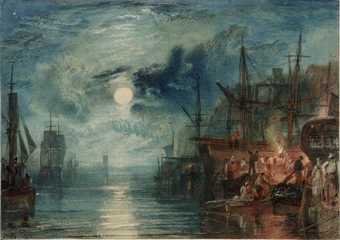
Joseph Mallord William Turner
Shields, on the River Tyne
(1823)
Tate
J.M.W. Turner may have regarded himself first and foremost as a landscape painter, but his art tells us a lot about the volatile and rapidly modernising times that he lived through. His lifelong interest in the inventions, conflicts, politics, society, culture and science of his time influenced many of his most original works and transformed his way of painting.
Here are six ways in which Turner used art to reflect his world as it transformed around him.
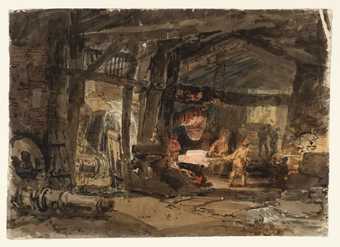
Joseph Mallord William Turner
The Interior of a Cannon Foundry
(1797–8)
Tate
1. Industry
As a young man, Turner made tours across Britain with his sketchbooks. He visited sites in Wales and northern England where he saw firsthand the impact of new manufacturing processes on the landscape and the people who lived and worked there. A handful of early drawings and watercolours show his fascination with industry.
The images above give us a glimpse inside a foundry producing cannon. These were used on ships fighting in the French Revolutionary Wars, a conflict that engulfed Europe between 1792 and 1802.
As so often in Turner’s work, it is impossible to know where his sympathies lie: with the men carrying out the work or the owners of the foundry? Are the cannon intended to demonstrate patriotism or to criticise the labour underlying the war effort?
2. War
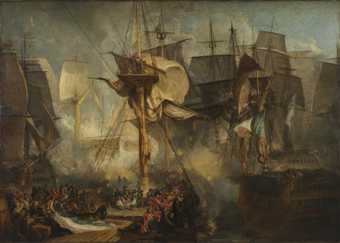
Joseph Mallord William Turner
The Battle of Trafalgar, as Seen from the Mizen Starboard Shrouds of the Victory
(1806–8)
Tate
Britain was at war somewhere in the world for most of Turner’s life. In particular, the French Revolutionary and Napoleonic Wars inspired him again and again to create paintings, sketches and poetry. First declared on Britain and Holland by the new radical-republican government in Paris and expected to be short and contained, the Wars became a clash of empires and ideologies fought on a global scale.
British military commander Horatio Nelson defeated the French and Spanish navies at Trafalgar on 21 October 1805, but died during the battle. This led to public outpourings of joy and grief in Britain. Turner’s dramatic painting shows Nelson collapsing on the deck of his ship the Victory, struck by a French sniper’s bullet just as the French concede defeat. The picture was praised as the ‘first British epic’ combining the death of a ‘hero’ with ‘the whole of a great naval victory’.
However, by the time Turner came to paint The Field of Waterloo, his attitude seems to have changed. The defeat of France at the battle of Waterloo on 16 June 1815 ended the Napoleonic Wars after more than a decade of conflict. Turner visited the battlefield in 1817 and filled a sketchbook with drawings. This painting, made the following year, neither celebrates the battle nor takes the British side. Instead, the moonlit view of the battlefield suggests compassion and tragedy. The field is covered with the dead bodies of soldiers from all sides of the conflict. Pictures of battles were expected to be patriotic, but Turner depicts what the poet Byron described as ‘friend, foe, in one red burial blent’.
3. Travel
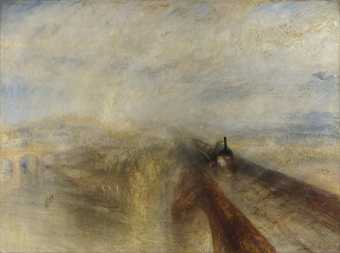
Joseph Mallord William Turner, Rain, Steam and Speed exhibited 1844. The National Gallery, London. © The National Gallery, London
Steam power and its by-product, speed, were among the defining features of Turner’s age. The railway, in particular, revolutionised the way people thought about distance, speed and time. Creating a new network across Britain’s landscape, the railways brought places closer together and made it possible for people to travel at previously unimaginable speeds. Regional time zones were gradually replaced by the standardised Greenwich Mean Time, so that railway timetables could be created. The railways brought fundamental changes to the way that life was lived – whether you used them or not.
Turner was the first artist to bring ‘railway mania’ into the arena of academic oil painting with this picture of the Great Western Railway. A Firefly engine pulls a train across the Thames on Maidenhead bridge at 50 or 60 miles per hour. The old road bridge on the left recalls slower journeys of the past.
The picture divided opinion. The art critic John Ruskin, no fan of trains, dismissed it as an 'ugly subject'. The novelist William Makepeace Thackeray, however, wrote more positively that ‘The world has never seen anything like this picture.’
4. Politics
Few other artists of the time were more engaged with painting the politics of their day. However, it is not always easy to identify Turner’s personal political views when we look at his work. This may be because his patrons felt differently about the causes he supported, which meant he had to tread carefully.
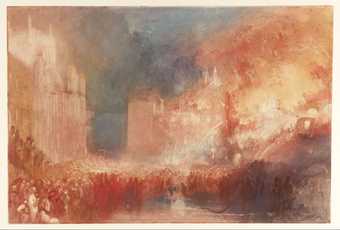
Joseph Mallord William Turner
The Burning of the Houses of Parliament
(c.1834–5)
Tate
Turner painted this watercolour after witnessing the fire that destroyed the Houses of Commons and Lords in October 1834. A large crowd, held back by soldiers, watches firefighters tackling the blaze. Turner returned to the subject again the following year in two oil paintings imagining the view of the fire from the other side of the Thames. Turner made these works in the wake of the 1832 Reform Act of Parliament. This Act made significant changes to the electoral system in Great Britain. Perhaps Turner’s paintings were meant to suggest how the old order had been swept away.
5. Slavery
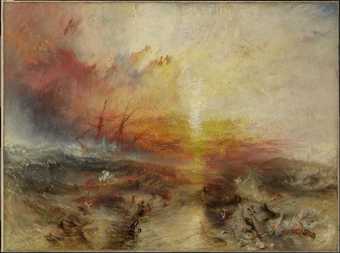
J.M.W. Turner Slave Ship (Slavers Throwing Overboard the Dead and Dying, Typhon Coming On) 1840 Photo © Museum of Fine Arts, Boston
The World Anti-Slavery Convention was held in London in June 1840. This was the same year that Turner exhibited his painting Slave Ship (Slavers Throwing Overboard the Dead and Dying - Typhon Coming On) at the Royal Academy. The work is based on the Zong ship massacre of 1781. When the ship ran into trouble, the captain forced 133 slaves overboard to capitalise on the terms of his insurance. Turner accompanied his painting with lines from his poem Fallacies of Hope attacking the heartless commercialism of the slave trade.
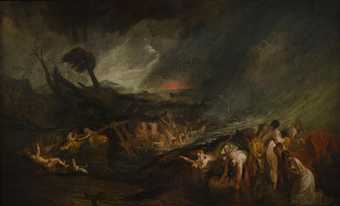
Joseph Mallord William Turner
The Deluge
(?exhibited 1805)
Tate
Earlier in his life, Turner had dedicated a print of his painting The Deluge to John Joshua Proby. Proby was an active opponent of the slave trade and may have commissioned the original picture. A Black man appears in a heroic role, rescuing drowning white women. The print’s publication coincided with the campaign of the Anti-Slavery Society whose activities influenced the passing of the Slavery Abolition Act in 1833.
Although this suggests that Turner was in favour of abolition, this is not necessarily a view he shared earlier in his life. His early patrons included slave owners as well as abolitionists. What’s more, in 1805 he bought a £100 share in a scheme to fund a cattle-breeding ranch in Jamaica worked by slave labour.
6. The Environment
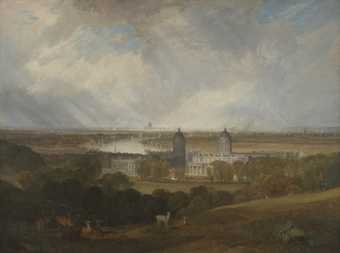
Joseph Mallord William Turner
London from Greenwich Park
(exhibited 1809)
Tate
Turner could not have known that the Industrial Revolution was pushing the world towards a climate emergency. However, as a landscape painter his artworks show a sensitive awareness of the effect that the industrialised world was having on the environment. When Turner painted this view of London from Greenwich Park, it was the largest, busiest city in the world. He exhibited the work in 1809, accompanied by his own poetry, which described a hectic, oppressive city: a ‘world of care’ beneath a ‘murky veil’ of cloud.
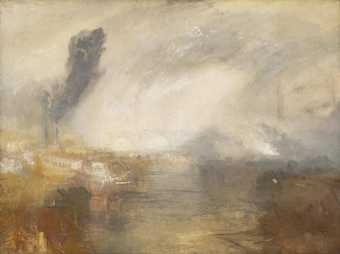
Joseph Mallord William Turner
The Thames above Waterloo Bridge
(c.1830–5)
Tate
In his later painting The Thames above Waterloo Bridge we see two steamboats belching smoke into a sky already polluted by industry. The first steamboat was built in London around the time this painting was made.
Steamboats offered benefits for leisure and industry, but they were not universally welcome on the river. Their wash eroded its banks, paddle wheels churned its filthy water, and their traffic competed with other boats. Cholera epidemics beginning in 1831–2 were attributed to ‘miasma’ from contaminated water.
A Parliamentary commission considered urban smoke pollution in 1829, which may have inspired Turner to make this painting.
